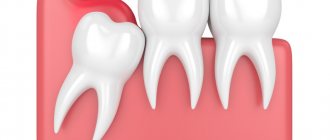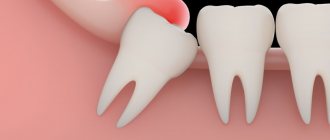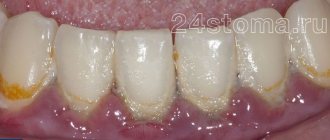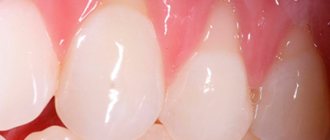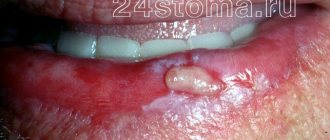The jaw of modern man is smaller than that of his ancient ancestor. This difference is 10-12 mm. The reason for the reduction of the jaw is a change in the nutritional pattern of living people. Food has become softer, carefully processed chemically or thermally. Therefore, the need for a large and powerful jaw disappeared. Wisdom teeth, which are located outermost in the dentition, have thus lost their practical use and become rudiments. Eights usually grow up later than others - between 14 and 25 years of age or later. Hence the wisdom-related name for the third molars, as dentists call them.
Every person has two rudiments of “eights” on the upper and lower jaw, but often there is not enough space for all the rudimentary teeth, and they cause a lot of problems. Wisdom teeth often fully erupt and not all become aligned. The figure eight may remain impacted, that is, hidden under the gum or bone, or may only partially erupt. The formation of third molars takes a long time. The growth of wisdom teeth can take years. Periods of growth usually alternate with phases of rest and development.
Unlike other teeth, eights do not have milk predecessors. In addition, it is very inconvenient to fully clean them due to their extremely difficult to reach position. All this leads to the development of pathological processes and difficulties during periods of their growth. Removing wisdom teeth is also considered a complex procedure with a high degree of trauma. The most common complaints that patients come to dentists with are swelling, inflammation and soreness of the gums near the “eight”. The causes of these uncomfortable phenomena are caries, pericoronitis, difficulties in the germination and eruption of wisdom teeth, as well as deep infectious and inflammatory processes in the root area and nearby tissues.
Painful eruption and incorrect position during germination
Periods of active wisdom teeth eruption often cause discomfort. Many people experience pain during this process, swelling and inflammation of the gum tissue. The reason for this manifestation is the absence of the previous milk tooth in the place where the figure eight grew. Third molars are forced to find a path of growth and break through dense bone tissue, which, given the large size of these teeth, becomes the cause of discomfort. Often, the lack of space for the normal position of the figure eight leads to its complicated germination.
In particularly difficult cases, the tooth takes on a dystopic position. It grows in an atypical direction, not upward, but at an angle. It causes injury to neighboring teeth and displacement of the entire dentition, up to bite deformation. A wisdom tooth growing horizontally can injure the cheek, tongue and roots of its “neighbors”.
Discomfort in the area of the extracted tooth
Unpleasant sensations, including throbbing pain, after tooth extraction are a natural and inevitable phenomenon, since it takes time to restore damaged tissue.
But after such an operation (especially after the removal of a wisdom tooth), patients should listen very carefully to their feelings so as not to miss the moment of possible complications, such as alveolitis (suppuration of the tooth socket as a result of the loss of a blood clot protecting the wound from infection).
How does pericoronitis occur?
If a wisdom tooth grows for a very long time or grows atypically, then partial gum loss above the surface of the tooth may occur. This creates a gum hood over the figure eight. This formed hood contains food debris that is very difficult to remove. They cause the proliferation of pathogenic bacteria, which ultimately leads to pericoronitis. In addition, if there is an upper double figure eight, then the gingival hood is constantly injured when biting, which becomes the cause of a non-infectious inflammatory process in the gum tissue. Pericoronitis can be acute (purulent or catarrhal) or chronic. Signs of pericoronitis:
- acute pain radiating to the neck or ear;
- soreness of the gum tissue during palpation and chewing;
- inability to open your mouth;
- purulent discharge;
- swelling of the mucous membrane;
- specific odor from the mouth;
- temperature increase;
- enlargement of the submandibular lymph nodes.
If the disease has taken a chronic form, then you will not have to wait long for noticeable painful manifestations. Pericoronitis regularly recurs with all the symptoms of an acute purulent form. Complications of untreated pericoronitis can be periostitis, abscess, osteomyelitis of the jaw or phlegmon. Therefore, if signs of pericoronitis are detected, urgent dental care is needed. The specialist, taking into account the phase and form of the disease, will select the appropriate treatment. Medication or surgery may be needed.
Sore gums: how to treat?
Competent and effective treatment of gums can only be carried out by a periodontist. Depending on the diagnosis and stage of the disease, he can prescribe a number of therapeutic measures to the patient.
- Professional hygiene . This is a mandatory procedure performed by a hygienist. In one procedure, it removes all dental deposits and bacteria living in them, not only from the surface of the teeth, but also under the gum. In addition, the hygienist will correct your home oral care, show you how to brush your teeth properly, and select a brush and products for you, taking into account your individual problems.
- Treatment with the Vector device. For effective treatment in scientific dentistry "Naudent" they use the Vector device (Germany). It delicately cleans the periodontal pocket to a depth of 11 mm and works gently even in the most difficult to reach places, ensuring maximum cleanliness. Thanks to ultrasound, Vector-therapy destroys the biofilm of microorganisms, and a powerful flow of liquid removes it from under the gums. A special solution washes and disinfects the gums. Thanks to its gentle effect, the system allows you to effectively and at the same time completely painlessly reduce the depth of periodontal pockets. Bleeding, pain and swelling disappear.
- Plasmolifting. The patient's blood plasma is injected into the inflamed areas of the gums by injection. This procedure is absolutely painless and has a beneficial effect on the condition of the gums: bleeding and inflammation disappear, and tooth mobility decreases. It is important that the healing effect is noticeable after the first procedure.
- Physiotherapy. A course of physiotherapy may include electrophoresis, massage, photodynamic therapy and ultrasound treatment. These procedures are prescribed as an addition to the main treatment. They have a complex effect, improve prognosis and reduce treatment time.
- Surgery. In advanced cases, when the inflammation has gone too far and therapeutic methods have not shown the desired result, the periodontist can only carry out surgical treatment. This may be curettage, gingivectomy or gum grafting. Doctors at scientific dentistry "Naudent" use the Fonalaser laser (Germany) for this purpose. It removes diseased gum tissue with virtually no pain or bleeding, and the recovery period is quick. Also, a diode laser is used to correct the gingival margin and remove tumors.
If you can’t go to the doctor right now, and your gums hurt, then you can temporarily reduce the level of inflammation on your own with the help of:
- Dental gels for gum pain relief
- Herbal rinses to relieve inflammation (chamomile, sage, eucalyptus)
Only an integrated approach can effectively solve problems with gum disease and forget about pain for a long time. Remember that it is important to take care not only of dental health, but also to monitor the condition of the entire oral cavity.
Infectious and inflammatory processes, caries
The hygiene of wisdom teeth is complicated by their inaccessibility, so they are prone to various dental diseases. Due to incomplete eruption, specific structure and prolonged germination, eights are predisposed to various painful conditions:
- Caries is a common disease that also occurs in impacted eights. Very often, wisdom teeth erupt with signs of crown destruction, even if they have been under the gum tissue for a long time.
- Complications of caries - periodontal cyst, pulpitis, periodontitis.
- Acute purulent-inflammatory processes - fistula, flux and abscess.
Content:
- Why it hurts to press on a tooth - the main reasons 1.1. Increased sensitivity 1.2. Traumatic injuries (history or recent) 1.3. Periodontitis 1.4. Inflammation of the gums 1.5. Poor quality dental prosthesis 1.6. Cyst 1.7. Caries 1.8. Pulpitis
- If pain occurs when pressing on a filled tooth
- What you can do yourself
When pain occurs in a tooth affected by caries, or at the base of which there is swollen and inflamed gum, everything is clear - you urgently need to go to the dentist and undergo treatment. But what to do if a person’s tooth hurts when biting and no visual defects are noticeable.
Is it possible to ignore this situation? Dentists are convinced that no. If acute or aching pain occurs when pressing on a tooth, you must definitely find out its cause. Otherwise, the risk of crown failure or root damage will increase in the future.
First aid
Before going to the dentist, you can relieve pain at home using certain pharmaceutical products.
- Drink a painkiller drug - Nimid, Nice, Analgin, Ketanov, Paracetamol, Tempalgin.
- Place the turunda on the swollen area with a special ointment or gel - Kamistad, Dentinox, Metrogyl-Denta, Cholisal.
- Rinse the mouth with antiseptic solutions - Miramistin, Chlorhexidine and Furacilin.
You can use home help methods for three days. Next, the supervision of a professional doctor is necessary. If the pain does not go away and the swelling does not go away, then you should immediately visit a dentist to find out and eliminate the cause of the painful condition. Inflammation during pericoronaritis is relieved by washing the gingival hood with pharmaceutical antiseptic solutions: Iodopharm, Potassium permanganate, Furacilin.
Discomfort under the filling
Unlike the previous case, pulsation in the gum under a recently filled tooth does not always indicate a mistake by the dentist. It is important to distinguish the stage of treatment here:
- When installing a temporary filling, pain and pulsating sensations are acceptable during the first few days, since temporary filling is most often carried out with the addition of a devitalizing agent to destroy the neurovascular bundle. The killing of the pulp occurs gradually, but a visit to the doctor is justified if the discomfort persists for more than 2-3 days.
- If discomfort is felt under a permanent filling, it is advisable to get dental care as quickly as possible. The causes of pain can be different; a competent diagnosis based on an X-ray examination of the problem tooth is necessary.
Traditional medicine methods
Folk remedies can be auxiliary methods for eliminating inflammation in the early stages. At the initial stages they are able to give excellent results. There are herbs, decoctions and infusions of which can have anti-inflammatory, disinfectant, wound healing and antimicrobial effects. To get such a decoction, you need to pour a teaspoon of beneficial herbs with a glass of boiling water and let it brew. Next, the resulting substance is filtered and the inflamed area is rinsed 4-6 times a day. Healing plants in this situation are chamomile, lemon balm, oak bark, calendula, sage and St. John's wort. A weak soda-salt solution can also have an anti-inflammatory effect. You need to rinse your mouth with it three to five times a day.
Clinical researches
As a result of clinical experiments using the Asepta series of products, which were carried out at the Kazan State Medical Academy N.V. Berezina, E.N. Silantieva, S.M. Krivonos, the effectiveness of the Asepta line of drugs has been proven as a means of etiotropic and symptomatic therapy as part of the complex treatment of patients with chronic inflammatory periodontal diseases.
Sources:
- The use of drugs from the Asepta line in the complex treatment of inflammatory periodontal diseases (N.V. Berezina E.N. Silantyeva S.M. Krivonos, Kazan State Medical Academy. Kazan.) N.V. BEREZINA, E.N. SILANTIEVA, S.M. KRIVONOS Kazan State Medical Academy
- The effectiveness of the use of Asept “adhesive balm” and Asept “gel with propolis” in the treatment of chronic generalized periodontitis and gingivitis in the acute stage (Municipal Dental Clinic No. 4, Bryansk, Kaminskaya T. M. Head of the therapeutic department Kaminskaya Tatyana Mikhailovna MUZ City Dental Clinic No. 4, Bryansk
- The effectiveness of the use of Asepta balm in the treatment of patients with inflammatory periodontal diseases (Doctor of Medical Sciences, Professor Elovikova T.M., Department of Therapeutic Dentistry, USMU. Yekaterinburg) Doctor of Medical Sciences, Professor Elovikova T.M. Department of Therapeutic Dentistry, USMU. Ekaterinburg
- Report on clinical trials to determine/confirm the preventive properties of commercially produced personal oral hygiene products: mouth rinse "ASEPTA PARODONTAL" - Solution for irrigator." Doctor of Medical Sciences Professor, Honored Doctor of the Russian Federation, Head. Department of Preventive Dentistry S.B. Ulitovsky, doctor-researcher A.A. Leontiev First St. Petersburg State Medical University named after academician I.P. Pavlova, Department of Preventive Dentistry.
Specialist help
In case of inflammation of the gingival tissues around the eights, the best solution is to immediately visit a dentist. The specialist will conduct an x-ray and a visual examination of the condition of the tooth and the surrounding area. Based on the examination results, competent treatment will be prescribed:
- Medication - by prescribing antihistamines and anti-inflammatory drugs, antibiotics, special ointments and gels, antiseptic baths.
- Surgical - cutting the gum or gingival hood, removing the figure eight that caused the problem.
If inflammation is accompanied by unbearable acute pain and severe swelling of the gums, a specialist performs a novocaine blockade. Sometimes laser therapy is prescribed, which has an anti-inflammatory effect on the affected area.
Sore gums: what to do?
If your gums hurt and are even swollen, you should immediately contact a periodontist. This is a dentist of a narrow profile, and it is better not to delay a visit to him if discomfort appears and the first signs of inflammation on the mucous membrane. It is this specialist who diagnoses and treats periodontal tissue diseases. You should also contact a periodontist regarding the prevention of gum disease.
What is the purpose of periodontal treatment?
- Removing dental plaque
- Cleaning periodontal pockets
- Preventing the spread of infection
- Activation of the immune system
- Development of a preventive measures program
Gum treatment will be most effective and successful at the initial stage of the disease.
If your gums hurt
- Use a soft toothbrush and special toothpaste
- Brush your teeth correctly and regularly
- Use dental floss, mouthwash and irrigator
- During treatment, avoid very hot, cold, sweet and salty foods.
- Temporarily avoid eating solid foods
What can happen if your gums are left untreated?
Many people ignore bleeding and inflammation of the gums because they consider these symptoms to be frivolous, but this opinion is wrong. If left untreated, the periodontal junction is gradually destroyed, teeth become loose and fall out.
According to statistics, gingivitis and periodontitis are increasingly diagnosed every year in patients aged 30–40 years. If you do not seek help from a doctor, then after 10–15 years, in some of them the disease goes from mild to severe, and teeth may begin to fall out.
Help with inflammation after removal
Due to their inaccessible location, full or partial impaction, and large tooth sizes, removal of third molars is often painful and traumatic. If after surgery to remove figure eights there is severe swelling, and it is accompanied by increasing pain for more than three days, this may be a sign of a disease called alveolitis. It occurs due to the entry of bone fragments, pathogenic bacteria into the wound formed after extraction, or due to the blood clot being washed out of the hole too quickly.
Signs of alveolitis are sharp pain in the wound area, redness of the gums, swelling of the extraction site, absence of a blood clot in the first week after the removal procedure, purulent discharge, fever, enlarged submandibular lymph nodes, general weakness.
It is very important to treat alveolitis immediately. This condition, without proper help, can cause tissue necrosis, abscess, phlegmon and osteomyelitis. In addition, alveolitis can lead to blood poisoning. If there are any signs of this problem, an urgent visit to the dentist is indicated.
Swelling of the gum tissue around the wisdom tooth is the first signal about the development of complex and dangerous dental diseases. Therefore, it is important not to rely on self-medication, but to consult a specialist in time.
Gingivitis
The first most common periodontal disease, the symptoms of which are bleeding and swelling of the gum tissue. Develops at any age. Gingivitis is common in pregnant women and teenagers. In this case, the disease begins due to changes in hormonal levels.
The pathological process can be limited to a small area or occur in a generalized manner, involving the gums in the area of all teeth. The initial stage of gingivitis is characterized by pain and bleeding in the gums when brushing your teeth. In the future, the gums may hurt even at rest.
Injury
You can injure your gums with an impact, as a result of a burn, even with careless brushing of your teeth. If you have injured the oral mucosa, it is better to carry out antiseptic treatment of the wound surface.
Often, gums are injured chronically. Tissues are subject to constant injury due to:
- broken bite;
- punctures (piercings) of the tongue, lips or cheeks;
- incorrectly selected prosthesis;
- habits of biting off threads with teeth, etc.
Chronic injury entails a serious complication - tissue necrosis, which is treated exclusively surgically.


